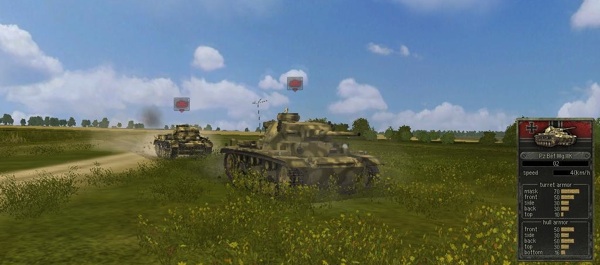Theatre of War 2: Kursk 1943 – Five Questions for the Developers

In the midst of dust, heat and Nebelwerfer and Katjusha rockets that are falling seemingly everywhere, the power of the German offensive seems unstoppable.
In an exclusive interview, ArmchairGeneral.com put five questions to David Phillppov, producer, and Oleg Bazarnov, project lead on the soon-to-be-released Theatre of War 2: Kursk 1943.
1. Kursk marks the first entry in the ToW 2 series to include a built-in campaign generator. Tell us a little about that.
In previous titles in the series users could create new scenarios using a wizard-like editor (in addition to normal one), building the scenario step-by-step, specifying their own and the enemy’s forces and placing them on the chosen map. However, that means that the author of the scenario already knows where and which enemies he will encounter since he added them himself. The new in-game Mission Generator lets you create new scenarios, describing your own and enemy forces by parameters like "Tank battalion" or "Veterans," without spoiling the fun by knowing enemy location before playing. You can even set most of these parameters to "Random" and the generator will create a new scenario to be played immediately or added to a new campaign. Germans vs. Germans or Russians vs. Russians engagements are possible, too. Both simple (wizard) and full editors are still available in addition to this in-game generator, of course.
{default}2. Hitler and Stalin threw everything they could into this battle. What are some of the more unusual or rarely seen weapons that will appear in the game?
In addition to widely known Panthers and Tigers, T-34s (there are four T-34 variants in the game), IL-2 and Ju-87 aircraft, "acht-acht" AA guns and Maxim heavy machine guns, the game offers many less-well-known infantry weapons, tanks, SPGs, AA, armored cars, guns, trucks and other armament. Players can utilize rare or generally less-famous weapons like the heavy AT rifle PzB 41 with conical bore, early SU-12M self-propelled gun, Sturmpistole (flare pistol-based grenade launcher), PTAB HEAT mini-bombs, Marder IIIH tank destroyer and others. Almost everything used by both nations on the south flank of the Kursk salient in July 1943 is in the game.
3. How do players utilize air power?
In addition to friendly and enemy air strikes and dogfights that are beyond a player’s control, the player can call in air support and direct it to the needed area on the battlefield. However, calling for reinforcements, air or artillery support costs special Victory Points, which can be earned by destroying enemy equipment or personnel or by completing sub-missions. They are also reflect player skill level at the mission’s end. Air strikes, reinforcements and artillery barrages can be called in during multiplayer battle in the same way.
4. The game has a number of story-based missions that include historical commanders, such as Major General Walter Hoerlein and Lieutenant General Ivan Christyakov. How do different historical commanders have different effects on play?
A player receives his orders from one of them, depending on the side he plays. ToW2: Kursk 1943 depicts the initial stage of the Kursk battle when mighty German offensive gradually ground to a halt, so on the Russian side you’ll usually receive defensive or counterattack orders from your superior, Ivan Chistyakov, while as the Germans under command of Walter Hoerlein you’ll be hard-pressed to attack and advance day after day. Players will find eight missions in the Soviet and nine in the German campaign—10 counting both variants of "Assault on Syrtsev."
[continued on next page]
Pages: 1 2

